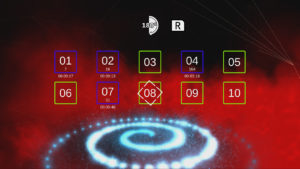
While I am not a die hard puzzle fan, it’s no wonder that I like puzzle games because puzzle games help our brain to relax. A little exercise helps our brain to keep it ready for quick thinking with problem solving, not to mention that it does wonders to develop the hand-eye coordination. With that being said, the Nintendo Switch is becoming the place to be for indie developers to bring their games to the platform. However, like many games in every genre, there are some that tend to go under the radar for many gamers. This is the case at least for me for Energy Cycle Edge, the sequel to last year’s Energy Cycle–a game that completely went under the radar for me. I tackled the sequel without any knowledge of what kind of game it was.

Once I booted the game and saw the welcome screen (that has a cool image that has nothing to do with the game itself), I hit play, and I was expecting a tutorial of sorts on how to play the game. However, I was greeted with the level select screen, so I choose a level and again expected a tutorial of sorts to help me understand the game and what I needed to do to complete it. Alas, there is no tutorial here because I feel that the developer thought that fans of the sequel would feel right at home with the game. That might be true, but what happens with people completely new to the game? Is it not a developer’s goal to bring their game to as many gamers as possible to make the game profitable? If so, how would you expect your game to reach new audiences if you don’t tell them how to play your game?
You might say, ” Ramon, you should’ve done your research before playing the game,” and you could be right. But even Pokemon games that have been making the rounds for several years have a tutorial on how to play the game, regardless if you are a pro or beginner. Since the developer’s goal is to reach wider audiences, why would they assume you already know how to play the game? Wouldn’t that result in less sales? I’m sorry if this feels like a rant, but I feel that the game was rushed to ride the Nintendo Switch popularity wave, and while that is not bad, in the end the player ends up being the most affected.
In any case, the objective of the game is simple: you need to change the cells color to a single one. However, it’s easier said than done because when changing a cell’s color, other cells that are connected horizontally and vertically will change too. You need to strategize your moves, so you can beat the level. A wrong change could mess up your efforts, but it can be corrected by changing the correct cells color. This sequel adds something new to the mix. By pressing L or R, you can rotate the cells, revealing another layer of cells to change color. However, you need to finish the cells before you. Before changing the cells on the back, I think that it adds another layer of difficulty and helps extend the replay value specially on bigger puzzles. When you finish the level, you are taken to the level select screen, and there new information appears like the time you took to finish the level and the amount of moves used. For those perfectionists out there, there is an incentive to play again to beat your record. While there is nothing more than the 44 levels present in the game, in the settings, you can set up Classic Cells in which the cells get the appearance of previous game. In Random Mode allows you to start the level with a sequence that will start rotating and changing the colors randomly for the cells once the sequence ends you start your game.
Graphically the game looks okay. I like that the backgrounds don’t disturb you and that you can focus on finding the way to change the cell’s color. I also like the neon like color of the cells. The music is really good, and the IDM/Ambient tracks are varied and fit the game well.
Bottom Line: Energy Cycle Edge is a game that feels rough around the edges. While the puzzles are challenging, and I took my time to finish them, the fact that a tutorial was overlooked feels that the game was rushed to be released. If you are a fan of the series, you know what you will get, but for newcomers, the price point could be enticing. Ultimately, it’s up to the buyer to determine the game’s worth. Personally, it’s hard for me to recommend this game based on the reasons explained above, and it’s a shame because once I figured out how to play the game it was somewhat fun.
A Review code was provided for this review.

